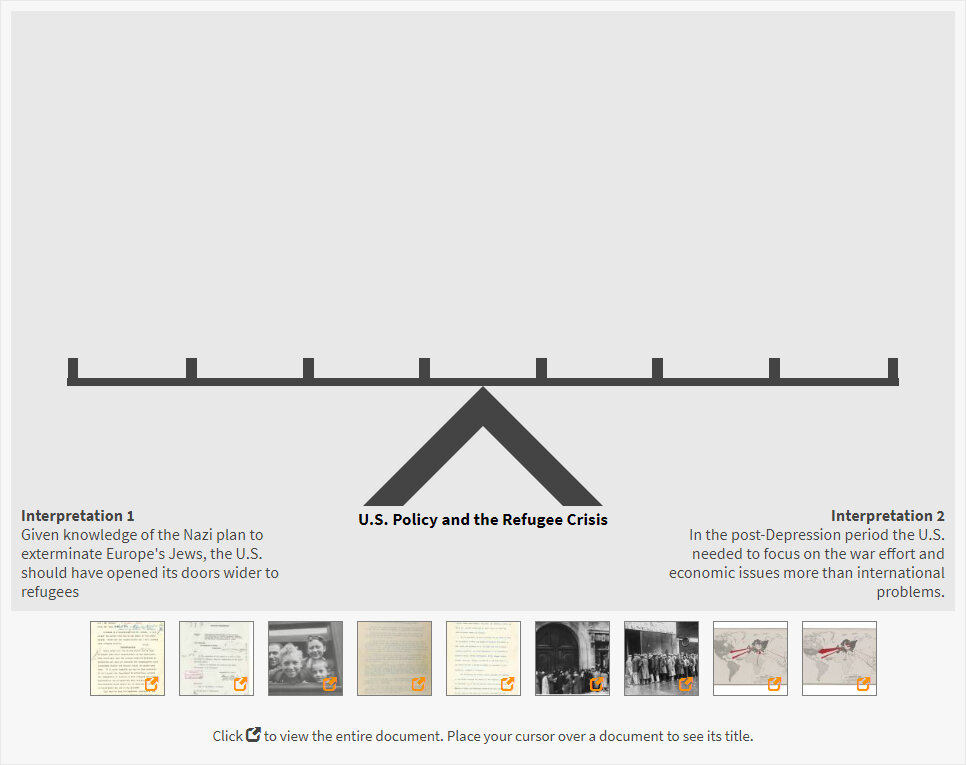This activity introduces students to the dispute between U.S. Government agencies over rescuing Europe's Jews from extermination during the Holocaust. Using memos from the State and Treasury Departments, as well as presidential proclamations and Congressional legislation, students will:
- Identify impediments to the admission of refugees to the United States
- Explore actions taken by various U.S. officials to both rescue and block immigration of European Jews
- Explain the roles of the State and Treasury Departments in rescuing refugees
Suggested Teaching Instructions
This activity provides specific content and asks students to draw connections that go beyond observation to analysis and synthesis. For grades 10-12. Approximate time needed is 90-120 minutes.
Begin by providing students with historical context on America between the world wars, paying special attention to the effects of the Depression and attitudes toward immigrants in the period leading to the U.S. entry into World War II. You may wish to share the following information:
In 1938, the United States was slowly emerging from the largest economic depression up to that time. Americans were beginning to find employment, but many still blamed the lack of jobs on immigrants. American public opinion was strongly against easing immigration restrictions in place since the 1920s (see polls from the American Institute of Public Opinion on the
website of the United States Holocaust Memorial Museum
). In that same year, Nazi Germany invaded Austria and western Czechoslovakia, causing a refugee crisis. Europeans, especially Jews, tried desperately to find safe haven in the United States. According to the United States Holocaust Memorial Museum, "More than 1,200 ships carrying nearly 111,000 Jewish refugees arrived in New York between March 1938, when Germany annexed Austria, and October 1941, when Germany banned emigration." However, of the 27,370 visas available to Germans in 1938, 7,818 went unused while 139,163 remained on the waiting list. By 1940, the U.S. State Department was actively blocking attempts to bring more refugees into the country.
Encourage students to keep the following questions in mind as they complete the activity and analyze primary sources:
- What reasons did the U.S. Government have for wanting to limit the number of refugees coming into the United States?
- What evidence did the Government have about the Nazi plan to exterminate Europe’s Jews, and how did that contribute to a change in U.S. immigration policy?
Open the activity and select one of the documents. Model careful
document analysis.
When you have completed the analysis, demonstrate how the scale works and ask students to place the document they just examined on the scale according to the interpretation it best supports:
Given knowledge of the Nazi plan to exterminate Europe's Jews, the U.S. should have opened its doors wider to refugees OR in the post-Depression period the U.S. needed to focus on the war effort and economic issues more than international problems. Explain to students that they should place each photograph, film clip, and textual document on the scale based on careful document analysis.
After students complete the activity, they should click “When You're Done” and answer the questions:
- On which side of the scale did most of your evidence fall?
- Why did you tip the scale the way you did?
- What lessons have been learned?
Conduct a class discussion based on students’ answers. Immigration to the United States has been a subject of debate since the nation’s founding. Whether in wartime or times of peace, the national value “Give me your tired, your poor” may conflict with the economic and political realities of the day. What do you think should be the primary concern governing American immigration policy?
This activity uses documents from the National Archives and the United States Holocaust Memorial Museum, and it supports the
exhibit Americans and the Holocaust. (For a virtual tour of the exhibit with Curator Daniel Greene, see C-Span for parts 1 and 2.)
This activity was created by National Archives volunteer Cynthia Peterman.





